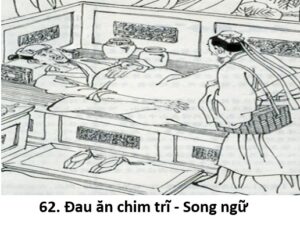62. Đau ăn chim trĩ – The Patient Eats The Pheasant Meat – Song ngữ
Sakyamuni’s One Hundred Fables
Kinh Bách Dụ
English: Tetcheng Liao
Việt ngữ: Hòa Thượng Thích Tâm Châu
Compile: Lotus group

- The Patient Eats The Pheasant Meat – Đau ăn chim trĩ
Once upon a time, there was a man who was seriously ill. A skillful physician prescribed that he could be cured by eating some pheasant meat. After he finished eating one, the patient did not eat it again.
Xưa có người bị bệnh nặng quá, thầy thuốc coi bệnh bảo phải ăn thịt chim trĩ hàng ngày mới khỏi. Người ấy nghe lời ra chợ mua được một con chim trĩ về làm thịt ăn. Ăn hết không mua nữa.
Afterwards, the doctor came to him and asked, “How do you feel now?”- The patient replied, “You have told me to eat some pheasants. Now that I have eaten it, I dare not eat it again.”- The physician said, “But why not? How can you expect to be cured with only one pheasant?”
Sau đó, thầy thuốc đến hỏi: “Ông khỏi hẳn chưa?” Người có bệnh đáp: “Trước thầy bảo tôi ăn thịt chim trĩ hàng ngày nhưng tôi ăn một bận thôi, nay bệnh vẫn chưa khỏi!” Thầy thuốc bảo: “Sao ông không ăn luôn đi, lại chỉ ăn một con thời mong khỏi bệnh sao được!”
This is also true with all the heretics. They should understand what the mind means on hearing such wise and skillful doctors as Buddha’s and Bodhisattva’s preaching. However, they cling to the view of permanence thinking that there is only one mind from the past, present through future, which does not undergo any change. This is just like the patient eating only one pheasant that his illness of ignorance and worries cannot be cured. All Omniscient Buddhas teach the heretics to abandon their prejudiced view of permanence. For all phenomena are subject to change at the time of thought. How can the mind remain unchanged! This is just like the physician’s telling the patient to eat more pheasants. So is Sakyamuni Buddha’s preaching to all men to understand all his teachings. Sakyamuni has it that things which can be ruined or destroyed are called impenitence. – Things which can be lasted are called continuity. – Once the context is understood, people will eradicate the wrong view of permanence.
Ngoại-đạo cũng thế. Phật, Bồ-tát là bậc Vô-thương lương-y bảo: “Nên giải tâm-thức”, thời ngoại-đạo chấp thường-kiến (tư-tưởng chấp thường còn mãi mãi cho quá-khứ, hiện-tại, vị-lai chỉ là một Thức (ví như một con chim trĩ) không có sự tàn-tạ, thiên-chuyển. Thế nên, không thể chữa khỏi được bệnh ngu-hoặc phiền-não. Chư Phật bảo các ngoại-đạo trừ bỏ thường-kiến vì “hết thảy mọi pháp niệm niệm sinh-diệt, sao lại có một Thức thường hằng bất biến?” Như thầy thuốc dạy ăn chim trĩ hàng ngày cho khỏi bệnh, đức Phật cũng thế dạy chúng-sinh hiểu các pháp có hoại nên không thường, nối-tiếp nên không đoạn là diệt-trừ được bệnh thường-kiến. (30)
- (30) Đoạn trên nói: Tâm thức chúng-sinh luôn luôn chuyển-biến và tương-tục không phải như ngoại-đạo cho “tâm-thức” là thường còn mãi mãi không thay đổi, hay cho là đoạn-diệt hẳn.
Sources:
Tài liệu tham khảo:
- http://www.buddhism.org/Sutras/2/FablesSutra.htm
- https://tienvnguyen.net/a615/kinh-bach-du-sakyamuni-s-one-hundred-fables
- https://phatphapungdung.com/phap-bao/kinh-bach-du-thich-tam-chau-dich-113682.html/3
- https://daitangkinh.net/?f=Kinh-Bach-Du/3
